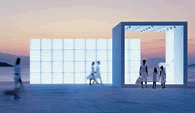Diffuse Transmittance
Certain materials have the ability to transmit and diffuse light. This principle is known as diffuse transmission and occurs with opal glass and opal plastic diffuser luminaires.
When a ray of light falls on translucent (light transmitting) opal material, some light is reflected and some light passes through the material. This light is scattered and diffused, thus spreading the brightness of the bare lamp over a wider area.
The area of illuminated brightness is therefore enlarged and for a given number of lumens coming from the luminaire, the lumens per unit area or candelas per unit area are reduced which in turn reduces the brightness, i.e. glare from the luminaire is reduced.
The amount of light that is emitted from a material, after passing through it, as a fraction or percentage of the light falling on the material is called the transmittance.
Refraction
When light passes from one transparent medium to another of different density, it bends. This is known as refraction, e.g. from air to glass the light bends towards the perpendicular to the surface. When light passes from a dense to a rarer medium, e.g. glass to air, the reverse occurs. If light is passed through a triangular glass prism, it is deflected from its original path.
Prisms, in glass or plastic, can be designed to control light. Plastics are used extensively in prismatic controllers for both interior luminaires and street lighting lanterns.
Glare
The discomfort or impairment of vision experienced when parts of the visual field are excessively bright in relation to the general surroundings.
Disability Glare
Glare which impairs the ability to see detail without necessarily causing visual discomfort.
Discomfort Glare
Glare which causes visual discomfort without necessarily impairing the ability to see detail. |



